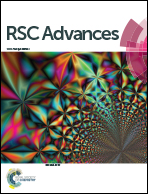LAPONITE®-pilocarpine hybrid material: experimental and theoretical evaluation of pilocarpine conformation†
Abstract
The intercalation of protonated pilocarpine (Pilo+) into model LAPONITE® (Lap) is here investigated in order to address its conformational properties upon entrapment. Pilo is an alkaloid available as a drug for the treatment of glaucoma and xerostomia, and clays are potential candidates for drug delivery. Therefore, the physico-chemical characterization of the Pilo-Lap material is here studied through chemical elementary analysis, X-ray diffraction, mass spectrometry coupled to thermogravimetric analysis (TGA-MS), solid state 13C nuclear magnetic resonance (NMR) and Raman spectroscopy. The experimental spectroscopic data are confronted with performed calculations which confirmed the presence of pilocarpine, while the XRD data also show the immobilization of Pilo+ into the clay. TGA-MS analyses indicated a significant modification in the thermal decomposition profile of the organic species after intercalation. A DTG peak associated with the release of carbon dioxide and water molecules is observed at 315 °C for PiloHCl and at 378 °C for Pilo-Lap. Supported by the theoretical calculations, the experimental XRD, vibrational and NMR spectra suggest that pilocarpine may undergo geometrical changes upon the intercalation process. A characteristic fingerprint was observed as a vibrational change in the band at 768 cm−1 for PiloHCl (assigned mainly to the lactone ring breathing vibrational mode) and a band at 782 cm−1 for Pilo-Lap (assigned mainly to the imidazole ring bending in the plane) in the Raman spectra.



 Please wait while we load your content...
Please wait while we load your content...